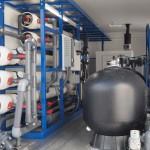Plasterer and industry advocate Alan Smith added a new division to his Orange, Calif.-based resurfacing and remodeling firm, Alan Smith Pools.
He has entered the mobile filtration business with Purified Pool Water, which treats and filters water to remove total dissolved solids and other substances as an alternative to draining and refilling. The California Pool & Spa Association has stated it believes this technology will become standard in the near future as the state tries to live with a tight water supply.
Based at Alan Smith Pools’ headquarters and its Coachella Valley satellite office, the new division utilizes technology developed approximately five years ago by retired builder Jerry Gilbert and service firm owner Rick Lathrop, who formed Pool Water Purification in Lake Havasu City, Ariz. “[The] process makes this water as good if not better than the original fill water,” Smith says.
The plan
The system on wheels incorporates a multiple-membrane reverse osmosis system with various filters. The idea is to treat water with a chemical regimen that could dissolve scale from the interior surfaces, recycle the water, then balance it.
“You could extend the life of the pool plaster or pebble or quartz,” Smith says.
He may license the name and technology to professionals who wish to undergo his training regimen and offer the service. Smith has attained first-selling rights from Pool Water Purification, which would allow him to purchase the equipment, sell it to other individuals and provide the training.
“This process … is not something you pick up in an afternoon seminar,” Smith says. “It takes months of doing it over and over. If [they] aren’t doing it right, the machines are going to plug up and get ruined.”
The four-person staff includes General Manager Brett Gereau, previously a sales rep for Alan Smith Pools. Before that, he owned a service and repair firm.
So far, Smith has purchased two trailers. While a third is being manufactured, another is on loan from Gilbert’s company. At approximately $250,000 each, the rigs can move 90- to 130 gallons per minute. They can work separately, with each treating a smaller pool or working longer on a larger installation. Or the rigs can be combined to treat larger pools faster.
Smith hadn’t originally planned to open a new business. He was simply looking for a way to swap one pool’s water with another as they’re being replastered. But Smith soon decided he didn’t want to fill newly plastered pools with old water. Optimally, freshly applied material should not be exposed to high TDS and cyanuric residuals.
Also, the outlook for water restrictions in the drought-ridden state changed over time. Where they seemed inevitable a year ago, with some municipalities instituting fairly stringent rules, the California Pool & Spa Association accumulated more successes in reversing such mandates throughout the state. Then talk of the El Nino phenomenon took hold, making it seem as if this would be less of a concern — though, to be sure, the state has a long way to go to make up for lost water.
As Smith learned more about Gilbert’s technology and considered how this could help with his plastering operation, an opportunity became apparent. “We realized that there was a niche market coming out of purifying existing pools where the water is so old and the rates and fines are too high to drain and refill,” he says.
So the new division doesn’t work for the sake of the plaster business. Most pools being treated are not set for a replaster. Instead, the rigs treat pools for the simple purpose of restoring the water’s health and sidestepping the need to drain and refill.
At first, most customers were conscientious homeowners whose pools needed refilling, but who didn’t want to waste water. Now it serves mostly commercial clients, since the high bather load in these pools requires more frequent water replacement. Many operators find themselves at a crossroads — the water clearly is inferior, but even local inspectors are loathe to require a drain and refill, because of the drought.
Smith and Gereau are proposing that clients have this service performed as a regular part of maintenance. “We can come in twice a year and keep it at a fairly low cost,” Smith says. “The more often you do it, the less time and cost for us to get in and out.”
Seeing the future
There is another reason Smith started his new division: He expects this drought to permanently change attitudes toward water. In his volunteer work with CPSA and APSP, he has met politicians and bureaucrats who believe water will be priced on a tiered scale in the future.
“The mindset of … people who set water policy is that clean water is a commodity, whether it’s a drought or not,” he says.
If this approach materializes, water for agriculture and other high-priority applications would sell for the best acre-foot prices, while higher fees will be garnered to use water for more discretionary purposes.
In that scenario, the mobile water purification process prove less expensive than refilling, Smith says. But he believes it also will create goodwill, to debunk notions that the pool and spa industry wastes water and doesn’t concern itself about conservation.
If things go that direction, he has positioned himself with a scalable model — he can begin adding more mobile filtration units and train operators, or perhaps begin licensing. If not, he can keep going as is. It’s already paying off. “It looks good for us to be doing it, and we actually get plaster work out of it,” he says.



